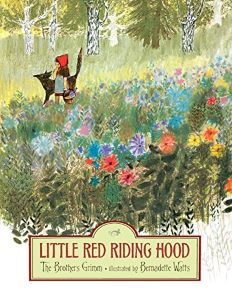Little Red Riding Hood

Content:
Little Red Riding Hood
Illustrator:
Bernadette Watts
Original title:
German
Original author:
Wilhelm Grimm, Jacob Grimm
Original language:
Rotkäppchen
Publication:
1968 by The World Publishing Company
Genre:
Fairy Tales, Fiction, Folk Tales
Current state:
Basic information has been added for this book.
It is under consideration and will be updated when it is evaluated further.
Book Guide
Search for this book used on:
"Little Red Riding Hood" is one of the best known folktales in the world and beloved by children on every continent. Who can resist the sweet red-hooded girl who, on her way to Grandmother's house, is tricked by a wolf but in the end comes away unharmed. This cautionary tale with a happy ending leaves everyone feeling good.
Retold with simple charm and illustrated with glowing paintings by one of the world's great interpreters of folk-and fairy tales, this edition of the cherished story is sure to be a favorite.
From the dust jacket
To view an example page please sign in.
To view awards and booklists please sign in.
To view the original book please sign in.
To view reprints of this book please sign in.
Resource Guide
Episode 70: Why Read Fairy Tales?
Released in 2020 by The Literary Life
Available formats: Streaming Audio
Length: 1 hr. 29 min.
View on the The Literary Life site
"Angelina Stanford and Cindy Rollins tackle the topic of fairy stories, discussing the what, why and how of reading them. Angelina shares the distinctive characteristics of fairy stories in contrast to other types of stories, such as myths. They deal with the question of whether fairy tales are 'escapist', the influence of the Grimm brothers scholarly work on interpreting fairy stories, and allowing the story to unveil its deeper truths without forcing meaning onto it.
Angelina gives an illustration of how to see the gospel messages in fairy tales by talking us through the story of Sleeping Beauty. She refutes the ideas that fairy tales are about human romance or are misogynistic. She also highlights some of the Enlightenment and Puritan responses to fairy tales that still linger with us today. Cindy and Angelina also discuss some common concerns such as the magical, weird, or scary aspects of fairy tales. Angelina also makes a distinction between folk tales, literary fairy tales, and cautionary tales."
Find This Book
Search for this book used on:



